Snap Circuits Basic Electricity SCP-10 Handleiding
Snap Circuits
Speelgoed
Basic Electricity SCP-10
Bekijk gratis de handleiding van Snap Circuits Basic Electricity SCP-10 (5 pagina’s), behorend tot de categorie Speelgoed. Deze gids werd als nuttig beoordeeld door 47 mensen en kreeg gemiddeld 4.8 sterren uit 24 reviews. Heb je een vraag over Snap Circuits Basic Electricity SCP-10 of wil je andere gebruikers van dit product iets vragen? Stel een vraag
Pagina 1/5

If you have any problems, contact Elenco
®
Copyright © 2014 Elenco®Electronics, Inc. All Rights Reserved. 150 Carpenter Ave. Wheeling, IL 60090● ●
(800) 533-2441 Fax: (847) 520-0085 e-mail: elenco@elenco.com Website: www.elenco.com or www.snapcircuits.net● ●
WARNING: SHOCK HAZARD -
Never connect Snap Circuits®
to the electrical outlets in your
home in any way!
WARNING: Always check your wiring before
turning on a circuit. Never leave a circuit
unattended while the batteries are installed.
Never connect additional batteries or any other
power sources to your circuits.
Basic Electricity
Model SCP-10
753159
Snap Circuits®uses electronic
blocks that snap onto a base
grid to build different circuits.
These blocks have different
colors and numbers on them so
that you can easily identify
them. Build the circuit shown by
placing all the parts with a black
1next to them on the clear base
grid first. Then, assemble parts
marked with a . Install three (3)2
“AA” batteries (not included)
into the battery holder (B3).
Set the meter (M5) to the 1A
setting.
Turn on the slide switch (S1).
The lamp (L4) comes on, and
the meter measures how much
electric current is flowing.
Project 1 Project 2 Lamp Current Batteries in Series
Electricity is the movement of sub-atomic charged
particles through a material due to electrical pressure
across the material, such as from a battery. Power
sources, like batteries, push electricity through a circuit,
like a pump pushes water through pipes. Wires carry
electricity, like pipes carry water. Devices like lamps use
the energy in electricity to do things. Switches control the
flow of electricity like valves and faucets control water.
The electrical pressure exerted by a battery or other
power source is called and is measured in voltage volts
(V). The “+” and “–” signs on a battery indicate which
direction it will “pump” electricity.
The is a measure of how fast electricityelectric current
is flowing in a wire, just as the water current describes
how fast water is flowing in a pipe. It is expressed in
amperes milliamps(A) or (mA = 1/1,000 of an ampere).
The “ ” of electricity is a measure of how fast energypower
is moving through a wire. It is a combination of the voltage
and current (Power = Voltage x Current). It is expressed in
watts (W).
The of a component or circuit represents howresistance
much it resists the electrical pressure (voltage) and limits the
flow of electric current. The relationship is Voltage = Current
x Resistance. When resistance increases, less current flows.
Resistance is measured in ( ).ohms W
If desired, use the voltage measured here (with 3 batteries) and the
current measured in project 1 to calculate the resistance and power of
the lamp:
Resistance equals Voltage divided by Current, and should be about 15
ohms. Power equals Voltage times Current, and should be about 1 Watt.
Your results may be different, because M5 is a simple meter with low
accuracy, and your battery voltage can vary.
1A
5V
Set the meter (M5) to the 5V setting, and turn on the slide
switch (S1). The lamp (L4) comes on, and the meter measures
the voltage from the 3 batteries.
Part B: Remove the left battery from the holder (B3), then snap
one side of the red jumper jumper on as shown, and touch
metal on the other end to the left spring in the battery holder.
Read the voltage on the meter, measuring 2 batteries, and
notice how the lamp is dimmer.
Part C: Now also remove the center battery from the holder and
touch metal on the end of the red jumper wire to the center
spring in the holder. Read the voltage on the meter, measuring
1 battery, and notice how the lamp is dimmer.
Placement
Level Numbers
Quiz answers:
1. B 2. B 3. C 4. A 5. B
Batteries are like electrical pressure, pushing electricity
through a circuit. Adding more batteries increases the
flow of electricity, making the lamp brighter.
Part B:
Part C:

Project 4 Heavy Load
Modify the preceding circuit
to match this one. Set the
meter (M5) to the 1A setting
and turn on the switch (S1).
The meter measures the
current. Try removing one
or two lamps and see how
the current changes. Also
try this circuit with both new
strong batteries and with old
weak ones.
This circuit is pictured on the front of the box, use that picture to help
in building it. Set the meter (M5) to the 5V setting. Turn on the slide
switch (S1) and use the meter to measure the voltage at points A, B,
C, D, & E in the circuit by connecting the end of the red jumper wire
to each of those points (the drawing shows it connected to point C).
Next, repeat the voltage measurements at points A, B, C, D, & E
while pushing the press switch (S2).
Project 3 Triple Voltage Divider
5V
Placement
Level Numbers
The circuit has three lamps connected in series, or two when S2 is pressed (S2 bypasses the last one).
A. Point A is the “+” battery terminal, so the meter is always measuring the battery voltage.
B. When S1 is on, point B is connected to the batteries, so the voltage will be the same as point A. When
S1 is off, the voltage is zero.
C. Point C measures the voltage after one lamp and across the other two, so should be about 2/3 of the
battery voltage. When S2 is pressed, the last lamp is bypassed, so point C is measuring across one of
the two remaining lamps, so should be approximately 1/2 of the battery voltage.
D. Point D measures the voltage after two lamps and across the last one, so should be about 1/3 of the
battery voltage. When S2 is pressed, the last lamp is bypassed, so point D is zero volts just like point E.
E. Point E is the “—” battery terminal, and will always be zero.
Kirchhoff’s Voltage Law, an important rule for analyzing circuits, says the total voltage driving a circuit must
equal the voltage drops within it. So the voltage drops across all of the lamps should equal the battery
voltage. (Your measurements may be a little different, because M5 is a simple meter with low accuracy.)
Set the meter (M5) to the 5V setting,
and initially keep the switch (S1) off.
The meter measures the battery
voltage with the lamps (L4) off.
Now turn the switch on to light the
lamps, and see if the battery voltage
changes. Next, remove one or two of
the lamps and compare the voltage.
Try this project with both new strong
batteries and with old weak ones.
Compare how the voltage changes
when you turn the switch on.
Project 5 Heavy Flow
1A
In this circuit, electricity flows out
of the batteries, through the meter,
then divides among the 3 lamps,
then all flows back to the batteries
through the switch.
The 3 lamps are connected in
parallel, because the current flow
divides among them. If one of the
lamps burns out, the others will
still work because has its own path
for electricity to flow along.
Batteries produce electricity using a chemical reaction,
and only a limited amount of the chemicals can react
together at once. Also, the chemical reaction slows as the
batteries get weaker. When a circuit wants more
electricity than the batteries can supply, the voltage
(electrical pressure) drops.
In this circuit, lighting all three lamps takes a lot of
electricity, so the voltage drops a little when the switch is
turned on. The drop in voltage is much greater for weak
old batteries than for strong new ones.
5V

Set the meter (M5) to the 1A setting and turn on the switch (S1). The
lamps light and the meter measures the electric current flow. Try
rearranging the parts in the circuit (keeping the “+” side of the meter
aligned with the “+” side of the batteries) and how it affects the circuit.
Next, try replacing any of the lamps (L4) with the press switch (S2)
and push it.
This circuit has the lamps connected in
a series (not in parallel, as in project 5).
This arrangement makes the lamps
dimmer because the battery voltage is
divided among the 3 lamps, but also
makes the batteries last longer
because less current is flowing.
Electricity from the batteries flows in a
loop, equally through each component
in the circuit.
Rearranging the components in a
series circuit does not change it,
because the same amount of electricity
is flowing through each component.
Replacing one of the lamps with the
press switch increases the current,
because the pressed switch has no
resistance to the flow of electricity.
If several lamps are arranged in series
and one burns out, none will work
because the only path for electricity is
blocked.
Project 8
Fast Bright, Slow Dim
Incandescent light bulbs, like those in the L4 lamps, make
light by passing a big electric current through a special
resistive wire (the filament), which gets so hot that it glows.
The two left bulbs (A & B) get less current than the right bulb
(C) so they take longer to heat up and don’t get as hot.
The meter measures the voltage cross left lamps A & B.
This voltage will be low when the left lamps are dim. When
you remove lamp B, both remaining lamps have the same
voltage across them and the same current through them.
In part A, you might have expected left lamps A & B to be
half as bright as the right lamp (C), because the current
through lamp C should divide equally between lamps A & B,
but instead lamps A & B are much dimmer. This occurs
because bulb filaments offer less resistance to the flow of
electricity when they are cold, and increase in resistance as
they heat up. Your L4 lamps have resistance of less than 5
ohms when they are cold, and about 15 ohms then bright.
1A
5V
Project 7 Find Your Own Parts
1A
Build the circuit shown; the can be
anything you want. Set the meter (M5) to
the 1A setting and turn on the switch
(S1). Touch various materials between
the snaps on the 4-snap wire and
batttery holder “—” side. Use the red
jumper wire to help make a connection if
needed. See which materials are good
at transporting electricity by watching the
meter current and lamp (L4) brightness.
If the meter reads zero, switch it to the
1mA setting to see if there is just a very
small current. With the 1mA meter
setting, try placing two of your fingers
across the snaps to see how well you
transport electricity; wet your fingers to
get better electrical contact. To help
protect the meter, always switch back to
the 1A scale before testing a new circuit.
?
?
Part A: Set the meter (M5) to the 5V setting. Push the press switch (S2)
for several seconds, while watching the meter. The meter is measuring
the voltage across the two left lamps (labeled A & B); its reading jumps
up when the switch is pressed, then slowly rises more for a few
seconds. Push the switch again while closely watching the lamps A &
B. Notice how lamps A & B initially are off, but turn on dimly within a
second or two.
Note: The voltage measured in this step will be small; in some cases in
may even be too small to measure with your M5 meter. M5 is a simple
meter, don’t expect it to be as accurate as normal electronic test
instruments.
Part B: Remove lamp B, and push the switch again. Now both
remaining lamps (A & C) get equally bright fast, and the meter shows a
higher voltage across the left lamp (A).
Part C: Replace the right lamp (C) with a 3-snap wire, and push the
switch again. Now the left lamp (A) gets the full battery voltage, as
shown on the meter.
Project 6 Loop
Product specificaties
| Merk: | Snap Circuits |
| Categorie: | Speelgoed |
| Model: | Basic Electricity SCP-10 |
| Kleur van het product: | Transparant |
| Gebruikershandleiding: | Ja |
| Stroombron: | Batterij/Accu |
| Aanbevolen leeftijd (min): | 8 jaar |
| Type verpakking: | Doos |
| Ondersteund aantal accu's/batterijen: | 3 |
| Voorgesteld geslacht: | Jongen/meisje |
| Batterijen vereist: | Ja |
| Aantal stuks: | 30 stuk(s) |
| Thema: | Elektriciteit |
| Batterijen inbegrepen: | Nee |
| Type product: | Elektrische set |
| Type batterij: | AA |
| EU TSD-waarschuwing: | Niet geschikt voor kinderen onder de 36 maanden |
| Awards: | Stuurpen |
Heb je hulp nodig?
Als je hulp nodig hebt met Snap Circuits Basic Electricity SCP-10 stel dan hieronder een vraag en andere gebruikers zullen je antwoorden
Handleiding Speelgoed Snap Circuits

31 Mei 2023

26 Mei 2023

26 Mei 2023

14 Mei 2023
Handleiding Speelgoed
- Swurfer
- HEXBUG
- MNKY
- Blaupunkt
- Viessmann
- Kogan
- MOTA
- Playmobil
- Valley Dynamo
- Dreamgear
- Jetson
- Lego
- Classic World
- Dickie
- Thames & Kosmos
Nieuwste handleidingen voor Speelgoed
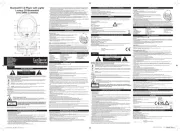
13 September 2025
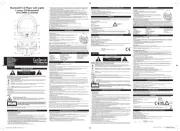
13 September 2025
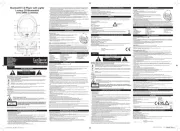
12 September 2025
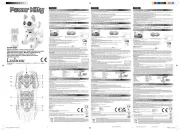
12 September 2025

12 September 2025
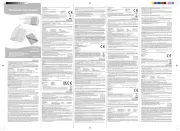
12 September 2025
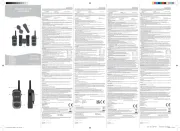
12 September 2025

12 September 2025
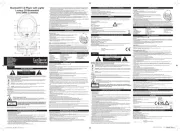
12 September 2025

12 September 2025
